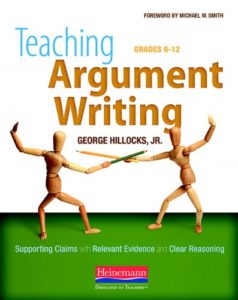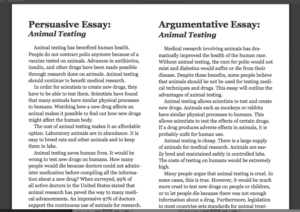
“What is the difference between the Common Core argument and opinion writing?” I’m addressing this with a group of middle school teachers tomorrow and it seems to be a question frequently asked in the field right now. I’ve been studying the difference for my own professional growth and thought I’d share some of my thinking. BTW – I’m considering the terms “opinion” and “persuasive” to be the same type of writing.
Teaching Argument Writing by George Hillocks (2011) is still my “go to” professional book on this hot Common Core topic. Hillocks describes the difference between persuasive and argument writing in the following quotes:
“In a persuasive (opinion) essay, you can select the most favorable evidence, appeal to emotions, and use style to persuade your readers. Your single purpose is to be convincing.” (Actually, there Hillocks, p. xvii, is quoting Kinneavy & Weaver, 1993.)
“Argument, on the other hand, is mainly about logical appeals and involves claims, evidence, warrants, backing and rebuttals…Argument is at the heart of critical thinking and academic discourse…” (Hillocks, 2011, p. xvii)
Another helpful description of the difference I found is at http://www.smekenseducation.com/argumentative-v-persuasive-writing.html –
“Students are used to aggressively convincing a reader to take their side in persuasive (opinion) writing. However, argumentative writing is much more balanced. It requires the development of both sides of an issue, offering several claims for one side while acknowledging that there are valid counterclaims from the opposition. Argumentative writing is not about winning to “get” something, but rather giving the reader another perspective to consider on a debatable topic.”
The link listed above also includes an example of a persuasive essay and an argument on the same topic (animal testing) with suggestions for how to teach.

So when we’re working with students – I would start by distinguishing the difference between the persuasive writing they are probably used to and the argument essay (which they are most likely less familiar with writing). Maybe implement a series of short exercises – like comparing the sample essays at the link above would be one.
Another might be turning a persuasive essay into an argument essay. For example, I found a “middle school” persuasive essay online called Cheaper Products? But at What Cost? There are no counterclaims addressed in this essay. What if middle school students read this one page essay about child labor in other countries and then searched for arguments that describe the vital wages child labor provides to impoverished families and added one paragraph to this essay addressing this counter claim.
In Teaching Argument Writing, Hillocks shares several simple ideas for teaching students how to begin to think “logically” and make arguments based on fact and judgment.
What I’m trying to get at here is that many times we start with writing a whole argument essay. This can be overwhelming for some of our students – especially if they are not familiar with this type of writing. Instead maybe we try to build background experiences (multiple, short encounters) with argument essays – reading lots of them, talking about the components of these essays – what makes them an argument versus a persuasive essay, revising essays that have already been written, making oral arguments and so forth.
I’m not done with this topic. I’m frustrated by the CCSS use of the term “reasons” (versus warrants) and I think the example of the “Student Sample, Grade 7: Argument” is not an argument at all – but instead is a student ranting about his opinion. More on that later.
